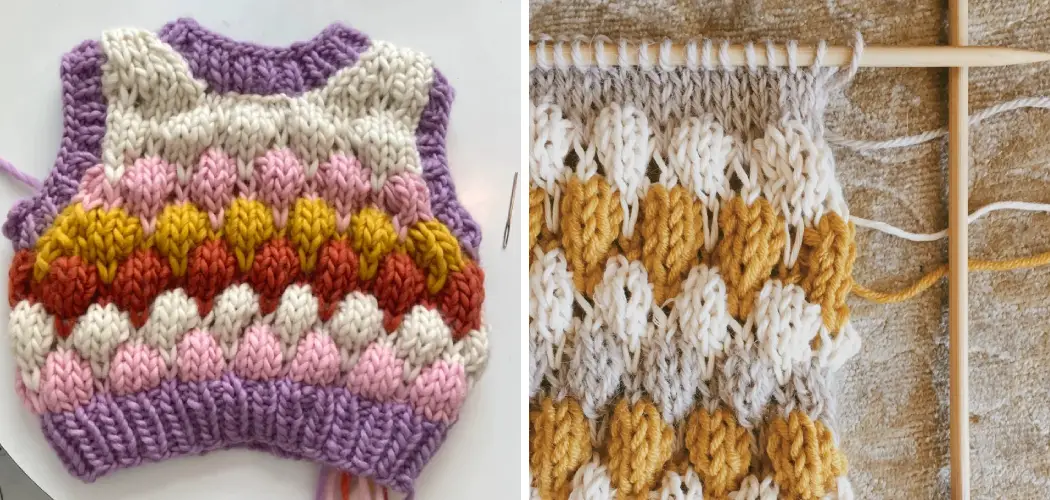Are you looking for a fun and creative way to add texture and interest to your knitting projects? Consider giving bubble stitch a try! With its bold puffs of yarn, this delightful stitch is sure to garner plenty of attention. It is perfect for cowls, scarves, hats, sweaters, and more.
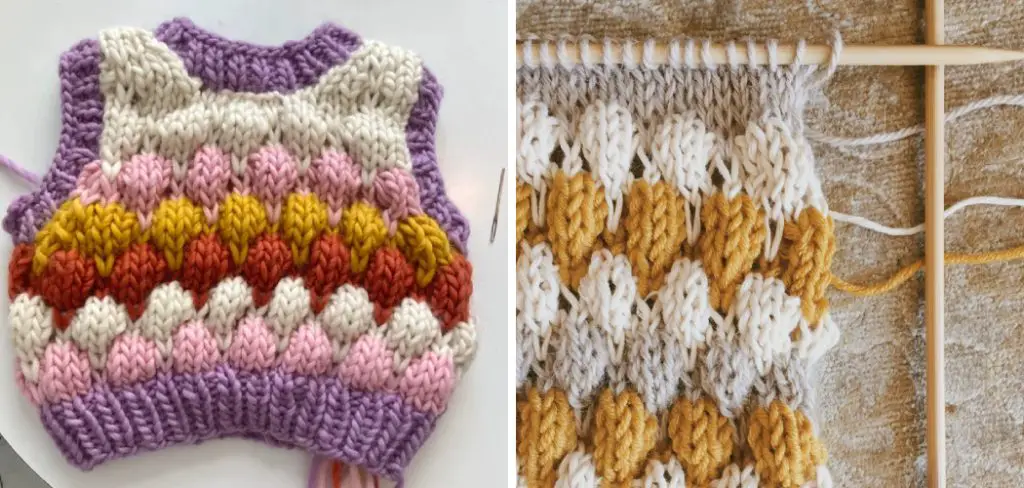
In this post, we’ll discuss what bubble stitch is and provide easy-to-follow instructions on how to knit bubble stitch yourself confidently. Whether you’re new to the world of knitting or simply want to learn a neat new technique – this guide will give you all the information & tips needed to get started creating some amazing bubble stitch designs of your own!
Materials You Will Need to Knit Bubble Stitch:
Yarn:
Any type of yarn can be used, but thinner yarn will create smaller and tighter bubbles while thicker yarn will produce larger and loose bubbles.
Needles:
To start, you will need two knitting needles. Straight needles are recommended, but circular needles can also be used if preferred.
Stitch Markers:
Stitch markers are optional but helpful in keeping track of your stitches and ensuring accuracy in the pattern. They can be easily made at home using a simple piece of contrasting yarn or purchased from your local craft store.
Scissors:
A pair of scissors will come in handy to cut your yarn and weave in any loose ends once you have finished knitting your project.
Measuring Tape:
While not necessary, having a measuring tape on hand will help ensure that your project is the desired size.
12 Step-by-Step Guidelines on How to Knit Bubble Stitch:
Step 1: Start by Casting on a Number of Stitches
Your pattern will indicate how many stitches you need to cast on. This usually ranges from 20-30 stitches; however, depending on the size of your project and yarn weight, this number may vary. Make sure to use a needle size that matches the gauge of your yarn for the best results. Otherwise, your bubbles may turn out too big or too small.
You can also experiment with different needle sizes to create different sized bubbles. The possibilities are endless! You can even mix and match different yarn colors to create a unique look.
Step 2: Knit a Few Rows of Stockinette Stitch
Once you have cast on your stitches, knit a few rows in stockinette stitch to create a base for your bubbles. This will give you a flat surface to work on before starting the bubble pattern. You can also use any other stitch pattern as a base, depending on your preference. It’s important to note that the bubble stitch pattern will only be applied on one side of your project.
The number of rows you knit will depend on how tall you want your bubbles to be. If you want taller bubbles, then knit more rows. This is where you can get creative and customize your project to your liking.
Step 3: Begin the Bubble Stitch Pattern
To start creating your bubbles, knit one stitch and then wrap the yarn twice around the right-hand needle. This will create a double stitch or “yarn over.”
Next, knit the next stitch as you usually would, but do not slip it off the left-hand needle just yet. However, make sure to keep the yarn over on the needle.
Step 4: Continue Knitting and Wrapping Yarn Over
Continue knitting one stitch and then wrap the yarn over twice until you reach the end of the row. This will create a series of double stitches on your right-hand needle. It may feel a bit awkward at first, but don’t worry – it will get easier with practice. You can also use your stitch markers to keep track of your stitches and make sure you don’t miss any.
The number of times you wrap the yarn over will determine the size of your bubbles. You can experiment with different numbers to create different-sized bubbles within the same project.
Step 5: Knit One More Stitch
After finishing a row of double stitches, knit one more regular stitch and then turn your work. It’s important to knit this extra stitch, as it will help anchor the bubbles in place. You will see why in the next step. The extra stitch will also help keep the edges of your project neat and tidy.
It’s recommended to slip this last stitch to the right-hand needle before turning your work, as it can be tricky to do once you have multiple bubbles on your needle.
Step 6: Purl Across the Next Row
On the wrong side of your work, purl across all stitches. This will create a smooth surface for the next row of bubble stitches. The bubbles will be visible on this side of your work, so make sure to keep an eye on them and adjust the tension of your yarnovers if needed.
You can also experiment with different stitch patterns on this side of your work, such as garter stitch or seed stitch, to add more texture and interest to your project.
Step 7: Knit the First Bubble Stitch
Once you have purled across the row, it’s time to start creating those beautiful bubbles! On the right side of your work, knit into the first double stitch created in the previous row. It may feel a bit tight, but this is where the extra stitch we knitted in Step 5 comes into play. It gives us enough space to work with.
Although the first bubble may seem a bit tricky, it will get easier to knit as you work your way through the row. It’s helpful to use your fingers or a knitting needle to push the previous stitches down, creating more space to work with.
Step 8: Knit and Slip Stitches
Continue knitting one stitch and slipping the double stitch off the left-hand needle until you reach another double stitch. When you come across a double stitch, simply knit it and then slip both stitches off the left-hand needle at the same time.
This step is crucial in creating the bubble effect. By slipping the two stitches off together, it creates a gathered and bunched look, resembling a bubble.
Step 9: Continue Knitting an Extra Stitch
As you work through the row, make sure to knit an extra stitch after every bubble. This will anchor the bubbles in place and help maintain their shape. It may be a bit tight to knit into this stitch, but it ensures that your bubbles won’t unravel. You can also use your fingers or a knitting needle to push the previous stitches down, creating more space to knit.
It’s important to maintain an even tension while knitting, as this will create a neat and uniform look for your bubbles.
Step 10: Knit Remaining Stitches
Continue knitting and slipping stitches until you reach the end of the row. You should no longer have any double stitches on your needle. If you do, simply knit them and slip them off together. It’s important to note that there may be a small gap between each bubble, but this will be fixed in the next row.
You can also experiment with different numbers of rows between each row of bubbles to create a varied and textured look. It all depends on your personal preference and the design of your project.
Step 11: Repeat Steps 7-10
Continue repeating steps 7-10 until you have reached your desired length for the bubble stitch pattern. You can mix and match different colors, yarn weights, and needle sizes throughout your project to create a unique and colorful design.
Remember to always knit an extra stitch after each bubble, and adjust the number of yarn overs to create different sized bubbles. The possibilities are endless with the bubble stitch pattern!
Step 12: Finish Your Project
Once you have reached your desired length, end your project with a few rows of garter or seed stitch to create a neat and finished edge. Bind off your stitches and weave in any loose ends.
Your project is now complete, adorned with beautiful bubbles that add texture and dimension. You can use this technique in a variety of knitting projects such as scarves, hats, sweaters, and even home decor items like blankets and pillows.
Following these steps on how to knit bubble stitch, you can create stunning bubble stitch patterns that will impress everyone who sees them. Have fun experimenting with different yarns and colors to create unique and eye-catching designs. Happy knitting!
Tips and Tricks to Knit Bubble Stitch:
1. Make sure you are familiar with the basic knit and purl stitches before attempting this stitch. It is also helpful to know how to increase and decrease stitches.
2. When working on the pattern, be sure to keep track of your row count so that you can maintain a consistent look in your work.
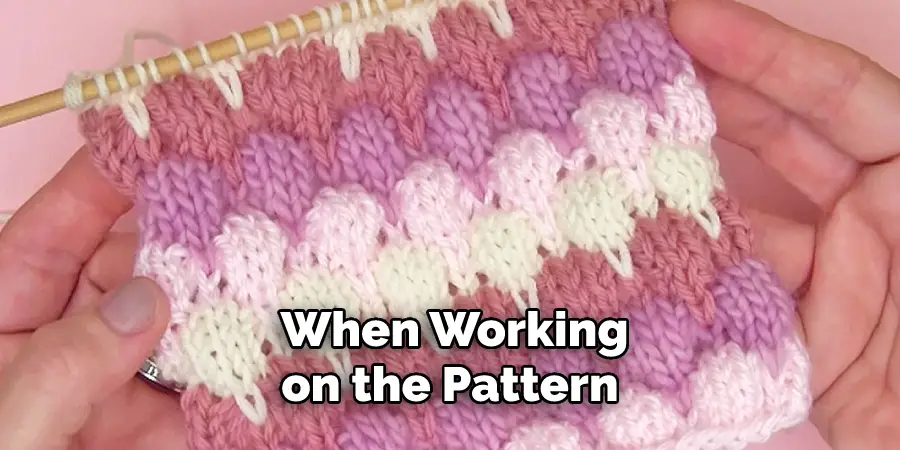
3. Make sure you are using the right size needles for your knitting project. This stitch requires a larger needle than normal so that it has enough room to create the bubble shape correctly.
4. Use a high-quality yarn when making the bubble stitch, as this will help ensure that the finished product is of good quality and looks great!
5. Take your time when working the stitch, and be sure to work it slowly and carefully, as this will make all the difference in how your finished project looks.
6. If you are a beginner knitter, practice the bubble stitch on a swatch before starting an actual project so that you can get used to it and make sure it looks good.
7. To create a more even look, use the same type of yarn throughout your project and always work in an even tense.
8. If you are having trouble getting the bubble stitch to come out correctly, try using a larger needle size or adding extra stitches in between each bubble to help keep the shape uniform.
9. Make sure you are reading the pattern correctly, as this will make all the difference in how your finished project looks. Be patient and take it step by step.
10. Finally, have fun with it! Knitting should be enjoyable, so don’t let yourself get frustrated if things don’t go as planned. Just keep practicing, and you’ll get it eventually! Good luck!
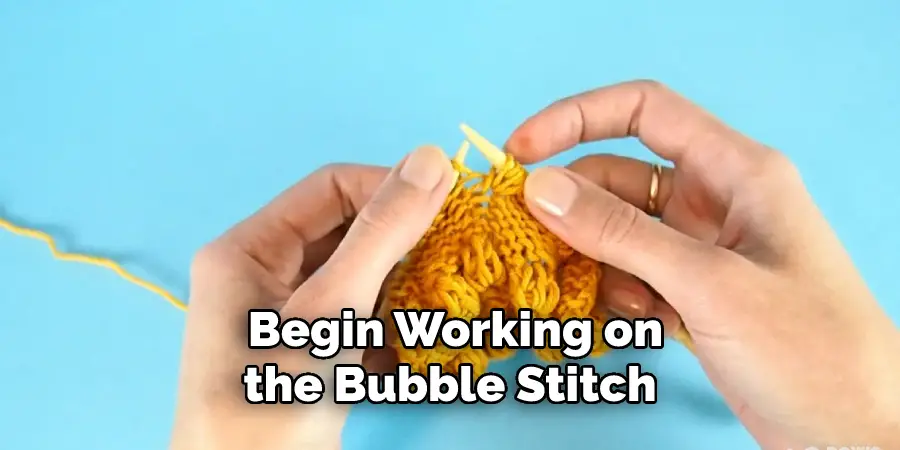
By following these tips and tricks, you should be able to knit the bubble stitch easily and create a beautiful finished product! Have fun with it, and enjoy the process of creating something unique and special. Enjoy knitting!
Things You Need to Consider While Knitting Bubble Stitch:
1. Needles:
You need to use circular needles instead of regular ones when knitting bubble stitches. This is because the stitch requires a bit of extra space in order for it to be successful. Make sure that your needles are the correct size for the project you are working on.
2. Yarn:
Choose a light and airy yarn, as this will help the bubbles be more pronounced. Look for a yarn that has some luster or shine. This will ensure that your bubble stitch looks nice when it’s finished. Right Yarn will also help to create an even and consistent look.
3. Gauge:
It’s important to use an accurate gauge when knitting bubble stitches. It will help you achieve even and consistent results in your project. Make sure to check the gauge of your yarn before beginning so that you don’t run into any problems later on.
4. Patience:
Knitting bubble stitches can be tricky, so it is important to take your time and be patient with yourself. Don’t be afraid to make mistakes; this is how you learn and grow as a knitter. Take breaks when needed, and don’t rush the process.
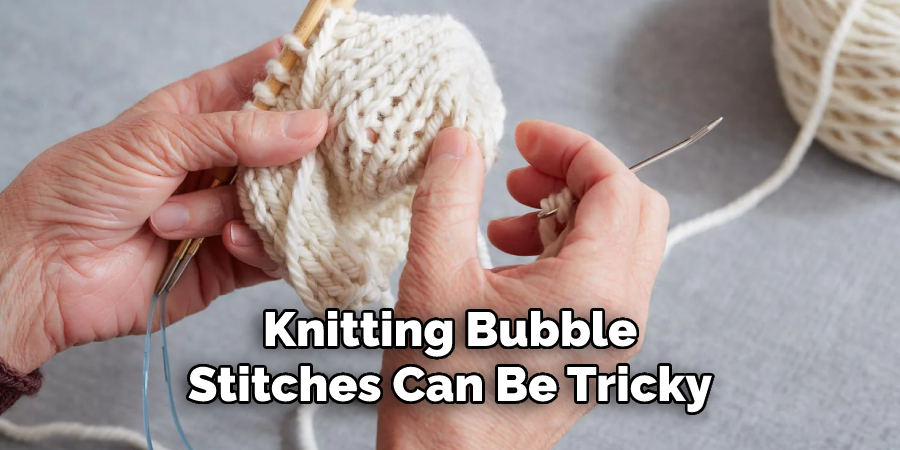
5. Blocking:
Once your project is finished, make sure to block it properly for the best results. This will help the stitches look even and neat. Blocking will also help the bubbles to be more pronounced and beautiful.
With these considerations in mind, you will be able to knit bubble stitch successfully and create beautiful pieces of work. Have fun, and enjoy the process!
Frequently Asked Questions
What Is the Best Needle Size for Knitting Bubble Stitch:
The recommended needle size to use when knitting bubble stitch is 3-4 mm. This size will ensure that your stitches are even and consistent throughout the project, which will make it easier to achieve a professional-looking finished product.
How Do I Begin Knitting Bubble Stitch?
To begin knitting bubble stitches, you should cast on an even number of stitches. After that, it’s time to make the actual bubble stitch. To do this, you need to knit two together through the back loop (k2tog tbl) and then yarn over (yo).
This will create a “bubble” in your work. You should then repeat this sequence until you reach the end of the row. When you turn your work, you will begin knitting two together through the front loop (k2tog tfl) and then yarn over again. This sequence is what creates the bubble stitch pattern. As you continue to knit, keep repeating these steps until you have reached the desired length of your project.
Can I Use Bubble Stitch in Other Projects?
Absolutely! Bubble stitch can be used in a variety of projects, from sweaters and scarves to blankets and shawls. The bubble stitch is an incredibly versatile pattern that looks beautiful when working on any project. It’s also an easy pattern to learn, so it’s perfect for beginner knitters. Have fun experimenting with different yarns and colors to create unique projects that are sure to stand out!
I’m Having Trouble with My Bubble Stitch Project – What Should I Do?
If you’re having trouble with your bubble stitch project, you can do a few things to troubleshoot. First, check your pattern and make sure that you haven’t missed any steps or skipped over any instructions.
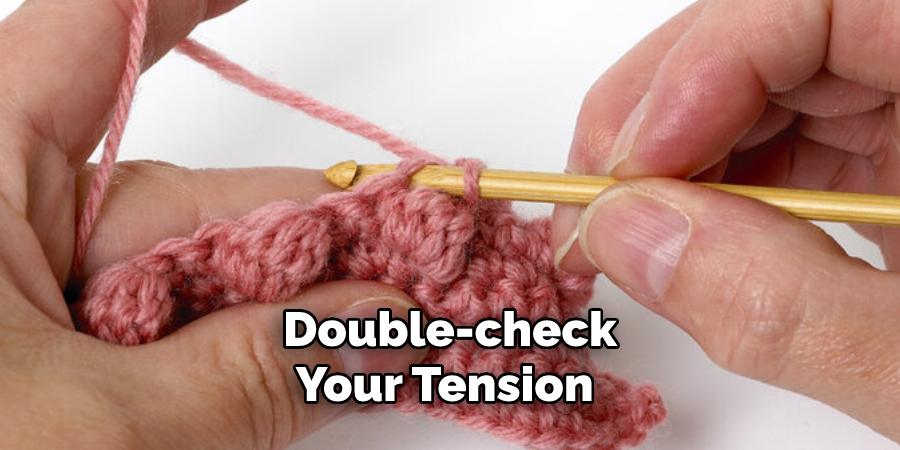
If everything seems correct, double-check your tension and needle size to ensure that they match the pattern’s requirements. Finally, if you are still struggling, seek help from experienced knitters online or in your local yarn shop. With enough practice and patience, you will be able to finish your project with ease!
Conclusion:
Now you’ve finished learning how to knit bubble stitch! It may seem intimidating at first, but once you’ve mastered your tension, the pattern will come together quickly and create a unique and beautiful design. Creating patterns out of simple tools can be satisfying and rewarding—especially when the result is original, like the bubble stitch.
Whether you knit it into a scarf or use it as an accent for other projects, you’ll have a one-of-a-kind item that nobody else has. So get creative with your knits, let your imagination soar, and feel proud of what you can create with just some yarn and needles!

